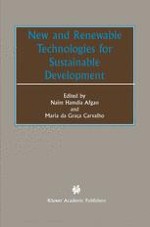2002 | OriginalPaper | Chapter
Renewable Energies in the Canary Islands: Actual Situation and Perspectives
Author : Julieta Schallenberg
Published in: New and Renewable Technologies for Sustainable Development
Publisher: Springer US
Included in: Professional Book Archive
Activate our intelligent search to find suitable subject content or patents.
Select sections of text to find matching patents with Artificial Intelligence. powered by
Select sections of text to find additional relevant content using AI-assisted search. powered by
The Canarian Archipelago is formed by seven islands and it is located 60 miles from the African coast and 750 from Cádiz, in the parallel 28. At the end of 1996 the Canary Islands had 1.605.400 inhabitants, and last year it received approximately 10.000.000 tourists. These facts confer special connotations which make the Canary Islands different from the rest of the European territory.Firstly, due to its geographical configuration, it has six autonomous electrical grids. Each island has there own small dimension electrical grid —weak grids- and the islands are very far away from the big supplying centres. If we also take into that there are no conventional energy resources on the islands, we realise that external energy dependency is almost complete. For the Canary Islands it is very important to increase the level of energy self-sufficiency. This can one be done developing renewable energy sources, mainly wind and solar energy.At the end of 1999 the percentage of RE power connected to the grid represented only about 5% (but in terms of electricity production was around 3%). This RE contribution comes mainly from wind energy (representing more than 98% of the RE connected to the grid).There is also another characteristic which represents the different situation of the Canary Islands: the high energy consumption for water production (mainly coming from desalination plants).In the Canary Islands a big effort is being doing in order to increase RE contribution, develop 100% RE communities and trying to couple desalination plants with RE. Part of this work is presented in this paper.
